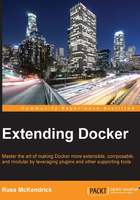
Conventions
In this book, you will find a number of text styles that distinguish between different kinds of information. Here are some examples of these styles and an explanation of their meaning.
Code words in text, database table names, folder names, filenames, file extensions, pathnames, dummy URLs, user input, and Twitter handles are shown as follows: "Once installed, you should be able to check whether everything worked as expected by running the Docker hello-world container."
A block of code is set as follows:
### Dockerfile FROM php:5.6-apache MAINTAINER Russ McKendrick <russ@mckendrick.io> ADD index.php /var/www/html/index.php
When we wish to draw your attention to a particular part of a code block, the relevant lines or items are set in bold:
version: '2'
services:
wordpress:
container_name: "my-wordpress-app"
image: wordpress
ports:
- "80:80"
environment:
- "WORDPRESS_DB_HOST=mysql.weave.local:3306"
- "WORDPRESS_DB_PASSWORD=password"
- "constraint:node==chapter04-01"
Any command-line input or output is written as follows:
curl -sSL https://get.docker.com/ | sh
New terms and important words are shown in bold. Words that you see on the screen, for example, in menus or dialog boxes, appear in the text like this: "To move to the next step of the installation, click on Continue."